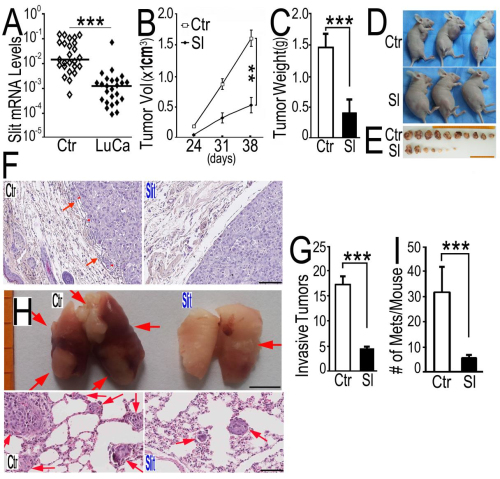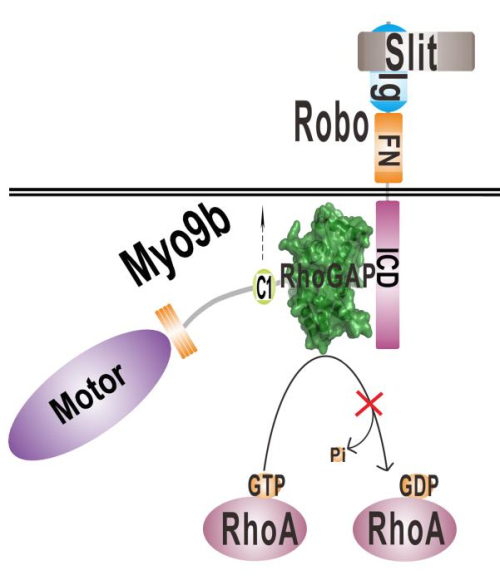Myo9b, A Key Player in SLIT/ROBO-mediated Lung Tumor Suppression
The neuronal guidance cue Slit (SLIT) comprises a family of secreted glycoproteins that were originally discovered to regulate axonal guidance and neuronal migration by binding to roundabout (ROBO) receptors. SLIT/ROBO signaling takes part in the modulation of chemokine activation and migration of cells from multiple lineages.
Recent studies suggest that the neuronal guidance molecule SLIT plays important roles in tumorigenesis and angiogenesis. The SLIT gene is inactivated in multiple types of cancers, often as a result of promoter hypermethylation or loss of heterozygosity (LOH). But the role of SLIT signaling in lung cancer and the underlying mechanisms remain unclear.
In a study published in The Journal of Clinical Investigation, Prof. WU Ying’s and Prof. FENG Wei’s groups have illustrated the molecular mechanism in which Myosin IXB (Myo9b), as a critical component in SLIT/ROBO signaling pathway, is involved in SLIT-mediated lung cancer suppression. This study presents the newly identified SLIT/ROBO/Myo9b/Ras homolog gene family, member A (RhoA) signaling pathway that restricts lung cancer progression and metastasis.
Prof. WU Ying’s group found SLIT inhibits cancer cell migration by activating RhoA. From yeast two-hybrid screens, one group of cDNA clones was identified to encode the Myo9b, as a protein interacting with ROBO. Myo9b specifically suppresses RhoA activation through its RhoGAP domain in lung cancer cells.
Prof. FENG Wei’s group successfully determined the structures of Myo9b RhoGAP domain and uncovered the molecular mechanism by which RhoGAP domain specifically recognizes RhoA. Moreover, they showed that SLIT inhibits Myo9b RhoGAP activity through the ROBO receptor, leading to RhoA activation. SLIT suppresses lung tumor local invasion and metastasis in the animal model. Myo9b is up-regulated in lung cancer tissue samples and high Myo9b expression is associated with lung cancer progression and poor prognosis in patients.
Their work suggests that targeting the SLIT/ROBO/Myo9b/RhoA pathway has potentials as a diagnostic and therapeutic strategy for lung cancer.
This work is supported by the National Basic Research Program (973) and the National Natural Science Foundation.
Full Text:
http://www.jci.org/articles/view/81673

Figure 1. SLIT2 suppresses lung cancer invasion and metastasis. (Image by IBP)

Figure 2. Working model depicting the SLIT/ROBO signal transduction pathway involving Myo9b and downstream RhoA.(Image by IBP)
Contact:
FENG Wei
Institute of Biophysics, Chinese Academy of Sciences
http://english.ibp.cas.cn/ibp_pi/AG/201311/t20131104_111917.html
Email: wfeng@ibp.ac.cn
ZHU Li
Institute of Biophysics, Chinese Academy of Sciences
Email: zhuli@moon.ibp.ac.cn

